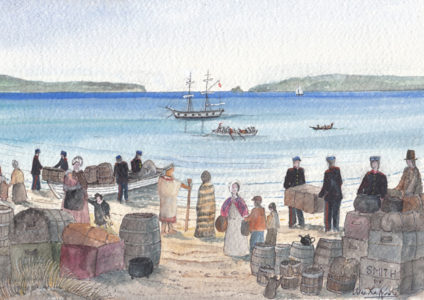
As Howick and districts count down to the 175th anniversary in 2022, the Times continues its series by ALAN LA ROCHE giving readers a glimpse of life as it used to be. The countdown began at the 170th in 2017
We have a lot to celebrate on November 15, 2020.
It was 173 years ago when the first Fencible-settlers arrived at Waipaparoa-Howick Beach welcomed by Ngai Tai chiefs Tara Te Irirangi and Wiremu Te Wheoro who could see co-operative advantages.
They had grown up at the Maraetai Mission school and had pigs, orchards of fruit trees, gardens of vegetables and abundant fish in the gulf.
Howick was settled by pakeha in 1847, one year before Otago settlers and three years before Canterbury settlers arrived.
Governor Sir George Grey made a special trip to Lyttleton in 1850 to welcome the 700 Canterbury Anglican immigrants but did not welcome the 900 Auckland Fencibles three years earlier.
The Fencible immigration to Auckland of 2463 people between 1847 and 1852 was larger than the Otago Free Church of Scotland immigration in 1848 or the Canterbury immigration in 1850 of over 700 immigrants.
Governor Grey knew these Fencible army pensioners were arriving but had made no preparation for them. On October 18,1847, the Governor along with Bishop Selwyn, surveyor Felton Mathew and Major Richmond walked from the Tamaki River and chose the site of Howick village. He had considered Matakana, Mahurangi and Kerikeri for Fencible settlements but Auckland needed to be protected from “possible” attack.
The first Fencible families left from Gravesend, London, on July 1, 1847 on the Minerva and, after a non-stop “favourable voyage” of 100 days, arrived in Auckland Harbour on October 8, 1847.
Immigrant ships tried not to stop en-route as the crew might desert ship for which there were severe penalties. The Minerva was built in 1845 in the Poplar district of East Indian docks on the River Thames, called by the locals “the Great Stink”- which it was!
Twenty-eight days later the “Minerva lot” boarded the Government brig Victoria with only a 12-foot draught which could safely moor off Howick Beach to unload the Fencibles and families from Auckland. Their boxes filled with clothing and tools were rowed ashore.
The next Fencible immigrant ship to arrive was the Sir Robert Sale from Cork, Ireland, escaping from the disastrous Irish Potato Famine when over a million Irish died. After 99 days at sea they arrived in Auckland on October 11, 1847, where they looked forward to fresh meat and fruit.
Carpenters off the Minerva, the Sir Robert Sale along with nine labourers, were selected to help erect two temporary sheds on the Howick Beach flats two weeks before the Fencible families arrived in Howick. One shed was for men, the other for women and children. Soon the Sir George Seymour arrived from London with more Fencibles and families who would be transferred to Owairoa, later called Howick. Within a month there would be more than 900 Fencibles and their families in Howick.
Raupo huts were built which shrank and leaked. In July 1848, it snowed in Howick, turning earth floors into thick mud. A few years later, wooden cottages were built.
When we visit Howick beach today it is hard to imagine our ancestors arriving by boat for a new life here. Howick was paradise to our early settlers, and beyond their wildest dreams.
Many of us also consider ourselves fortunate to live in Howick.
- Alan La Roche MBE, Howick Historian
alanlaroche@xtra.co.nz









